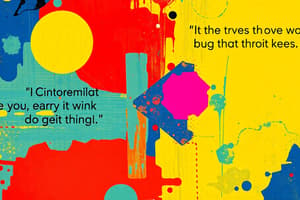Podcast
Questions and Answers
Which of the following sensory details is NOT an example of olfactory imagery?
Which of the following sensory details is NOT an example of olfactory imagery?
- The rhythmic ticking of the clock. (correct)
- The taste of the chicken noodle soup. (correct)
- The pungent smell of sulfur from the volcano.
- The sweet scent of lavender in the oil.
Which sensory detail is best illustrated by the example, "The rich, creamy sweetness of the homemade ice cream was an amazing treat after working hard on her modules"?
Which sensory detail is best illustrated by the example, "The rich, creamy sweetness of the homemade ice cream was an amazing treat after working hard on her modules"?
- Touch
- Taste (correct)
- Sight
- Smell
Which of the following statements BEST describes the role of imagery in writing?
Which of the following statements BEST describes the role of imagery in writing?
- Imagery is only effective in poetry and fiction and not in other forms of writing.
- Imagery is purely decorative and adds no real substance to the text.
- Imagery enhances the reader's understanding by creating vivid mental pictures. (correct)
- Imagery provides factual information and data to support arguments.
Which of the following sentences exemplifies tactile imagery?
Which of the following sentences exemplifies tactile imagery?
Which of the following aspects is NOT mentioned as an important characteristic of imagery?
Which of the following aspects is NOT mentioned as an important characteristic of imagery?
Flashcards
Imagery
Imagery
A literary device that appeals to the reader's senses through vivid descriptions.
Sensory Details
Sensory Details
Elements in writing that appeal to sight, hearing, smell, touch, and taste.
Visual Imagery
Visual Imagery
Imagery that appeals to the sense of sight with descriptive language.
Olfactory Imagery
Olfactory Imagery
Signup and view all the flashcards
Tactile Imagery
Tactile Imagery
Signup and view all the flashcards
Study Notes
Imagery as a Literary Device
- Imagery appeals to readers' senses (sight, sound, smell, touch, taste)
- Vivid descriptions create a strong mental picture
- Concrete sensory details enhance the experience
- Helps readers visualize the scene or subject being described
Types of Imagery
Sight
- Visual imagery depicts what can be seen
- Examples: Taal volcano, rose, grass, river
Smell
- Olfactory imagery evokes scents
- Example: Sulfur
Hearing
- Auditory imagery describes sounds
- Example: loud rumbling, clock, fan, snoring
Touch
- Tactile imagery describes what can be felt
- Examples: warm oil, soft spines
Taste
- Gustatory imagery describes flavors
- Example: chicken noodle soup, ice cream
Studying That Suits You
Use AI to generate personalized quizzes and flashcards to suit your learning preferences.




